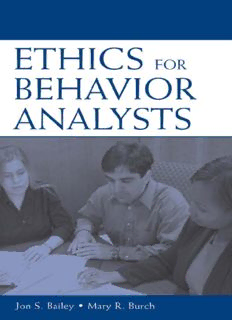
Ethics for Behavior Analysts: A Practical Guide to the Behavior Analyst Certification Board: Guidelines for Responsible Conduct PDF
Preview Ethics for Behavior Analysts: A Practical Guide to the Behavior Analyst Certification Board: Guidelines for Responsible Conduct
Ethics for Behavior Analysts A Practical Guide to the Behavior Analyst Certification Board Guidelines for Responsible Conduct Ethics for Behavior Analysts A Practical Guide to the Behavior Analyst Certification Board Guidelines for Responsible Conduct Jon S. Bailey Florida State University Mary R. Burch Board Certified Behavior Analyst LAWRENCE ERLBAUM ASSOCIATES, PUBLISHERS 2005 Mahwah, New Jersey London This edition published in the Taylor & Francis e-Library, 2008. “To purchase your own copy of this or any of Taylor & Francis or Routledge’s collection of thousands of eBooks please go to www.eBookstore.tandf.co.uk.” Copyright © 2005 by Lawrence Erlbaum Associates, Inc. Allrightsreserved.Nopartofthisbookmaybereproducedinany form,byphotostat,microform,retrievalsystem,oranyothermeans, without prior written permission of the publisher. Lawrence Erlbaum Associates, Inc., Publishers 10 Industrial Avenue Mahwah, New Jersey 07430 www.erlbaum.com Cover design by KathrynHoughtalingLacey Cover photo by Jon S. Bailey, featuring Mary KateLettera, Alex Vergara, and MarilynMcGhee. Printed with permission. Library of Congress Cataloging-in-Publication Data Bailey, Jon S. Ethicsforbehavioranalysts:apracticalguidetotheBehaviorAna- lystCertificationBoard:guidelinesforresponsibleconduct/JonS. Bailey, Mary R. Burch. p. cm. Includes bibliographical references and index. ISBN 0-8058-5117-8 (cloth : alk. paper) ISBN 0-8058-5118-6 (pbk. : alk. paper) 1.Behavioralassessment—Moralandethicalaspects—UnitedStates— Handbooks,manuals,etc.2.Behavioranalysts—Professionalethics —UnitedStates—Handbooks,manuals,etc. 3.Behavioranalysts— Certification—UnitedStates—Handbooks,manuals,etc. I.Burch, Mary R. II. Title. RC473.B43B355 2005 174.2'0973—dc22 2004061977 CIP ISBN 1-4106-1373-9 Master e-book ISBN Contents Preface vii PART I Background for Ethics in Behavior Analysis Chapter 1 How We Got Here 3 Chapter 2 Core Ethical Principles 12 Chapter 3 What Makes Behavior Analysis Unique? 25 PART II Understanding and Following the Behavior Analyst Certification Board Guidelines for Responsible Conduct in Real-life Contexts Chapter 4 Responsible Conduct of a Behavior Analyst 33 (Guideline 1) Chapter 5 The Behavior Analyst’s Responsibility to Clients 53 (Guideline 2) Chapter 6 Assessing Behavior (Guideline 3) 80 Chapter 7 The Behavior Analyst and the Individual 99 Behavior Change Program (Guideline 4) v vi CONTENTS Chapter 8 The Behavior Analyst as Teacher or Supervisor 113 (Guideline 5) Chapter 9 The Behavior Analyst and the Workplace 129 (Guideline 6) Chapter 10 The Behavior Analyst and Research 139 (Guideline 7) Chapter 11 The Behavior Analyst’s Ethical Responsibility 175 to the Field of Behavior Analysis (Guideline 8) Chapter 12 The Behavior Analyst’s Ethical Responsibility 182 to Colleagues (Guideline 9) Chapter 13 The Behavior Analyst’s Ethical Responsibility 190 to Society (Guideline 10) PART III Tips and Exercises for Students Chapter 14 A Dozen Practical Tips for Ethical Conduct 207 on Your First Job Appendix A Behavior Analyst Certification Board Guidelines 227 Appendix B Index for Behavior Analyst Certification Board 253 Guidelines for Responsible Conduct Appendix C Ethics Scenarios for Behavior Analysts 265 Appendix D Suggested Further Reading 283 References 287 Author Index 291 Subject Index 293 Preface EVOLUTION OF THIS BOOK AND HOW TO USE IT My first experience in ethics came when I was a graduate student in psychologyinthelate1960s.Iwasworkingwithaprofoundlydevelop- mentallydisabledyoungmanwhowasconfinedtoaheavymetalcrib in the small ward of a private institution in Phoenix, Arizona. Blind, deaf,nonambulatory,andnottoilettrained,my“subject”engagedin self-injuriousbehaviorvirtuallyalldaylong.Hishead-bangingbehav- ior against the metal bars could be heard twenty-five yards away and greetedmeeachtimeIenteredhisdepressing,malodorouslivingunit. Dayafterday,Isatbyhiscribtakingnotesonapossiblethesisconcern- inghowonemighttrytoreducehischronicself-injuriousbehavioror SIB(wecalleditself-destructivebehaviorinthosedays).Afterafewin- formalobservationsessions,andreadingthroughhismedicalchart,I hadsomeideas.Isetupameetingwithoneofmycommitteemembers, Dr. Lee Meyerson, who was supervising the research at the facility. “I’m observing a subject who engages in self-destructive behavior,” I began.“Hehitshishead10to15timesperminutethroughouttheday. I’vetakeninformaldataatdifferenttimesofthedayandIdon’tseeany consistentpattern,”Ioffered.Dr.Meyersonletmegoonforabout10 minutes,noddingandoccasionallytakingapuffonhispipe(smoking vii viii PREFACE wasallowedeverywhereinthosedays).Thenhestoppedmeabruptly andgesturingwithhispipebegantoaskmequestionsthatIhadnever thought about. Did I know my “subject’s” name? Did I have permis- siontoobserveandreportonthisindividual?Whogavemepermission tolookatthismedicalrecord?HadIdiscussedthiscasewithanyofmy graduatestudentcolleaguesorshownthedatainclass?Ihadnogood answers to any of Dr. Meyerson’s questions. I wasn’t thinking of my “subject” as a person, only as a source of data for my thesis. It never dawned on me that “Billy” had rights to privacy and confidentiality andthatheneededtobetreatedwithdignityandrespectnotasjustan- other “subject” to help me complete a masters thesis. As it turns out, Dr. Meyerson was ahead of his time in grilling me with ethical ques- tions that would not actually come up in legal circles for another ten years (see chap. 1). Dr. Meyerson’s questions helped sensitize me to looking at what I was doing from an extra-experimental perspective. HowwouldIliketobetreatedifIwasa“subject”insomeone’sexperi- ment?Or,howwouldIwantmymotherorsistertobetreated?“With kindness, compassion and respect,” is no doubt the quick response thatmostofuswouldoffer.Andsoitisthatethicsinpsychology,and particularlyinbehavioranalysis,canbeeasilypersonalizedandmade tangibleifwewilljuststopandthinkaboutwhatwearedoing. Studentstodayhaveagreatadvantageovermygeneration.Wehadno codeofethicsorguidelinestofollow;wehadonefootintheanimallab andoneintherealworldandweweretryingtofigureouthowtotrans- form powerful operant conditioning principles into effective treat- ments. It didn’t dawn on us at the time that ethics was involved at all, untilofcourse,weencounteredDr.LeeMeyerson.Today,graduatestu- dents in behavior analysis have nearly thirty years of applied research andpracticetofallbackon(andtolearnfromandbeheldaccountable forknowing).Inaddition,theyhaveawealthofresourcesonethicsin- cludingcaselawandprecedent-settinglegalfindings.Finally,students today have a perfectly legitimate, thoroughly researched, and well- vettedsetofguidelinesspecificallydesignedforourfield:TheBehavior AnalystCertificationBoard®(BACB)GuidelinesforResponsibleCon- duct.Inteachingthegraduatecourse“ProfessionalandEthicalIssuesin PREFACE ix Behavior Analysis” for the past five years, I have learned a great deal abouttheethicalissuesthatappeartobeuniquetoourfield(seechap.3) andhavebeendevelopinglecturesandtryingtodiscoverwaysofmaking ethics interesting, informative, and engaging for students who do not quiteseetherelevanceorappreciateourcautiousapproach.Onething I’vediscoveredisthatalthoughwenowhaveanexcellentsetofGuide- lines, they are somewhat dry and by themselves do not convey the ur- gency and relevance that they should. Reading the Guidelines is something like reading instructions for computer software: it’s clearly importantbutyouwouldratherjuststartusingit. Afewyearsago,Iwasscheduledtogiveahalf-dayworkshopatPenn StateonethicswithDr.JerryShook.Intheprocessofpreparingmyma- terials,Iwonderedwhatkindofethicalquestionstheparticipantsmight have.Dr.Shookarrangedinadvancetohaveeachparticipantwriteand submittoustwoquestionsor“scenarios”thatheorshehadconfronted intheworksetting.WhenIgotthequestions,Irealizedthatreadingthe scenariossuddenlymadetheethicalissuesjumprightoffthepage.Ibe- gan trying to look up the correct responses (according to the BACB® Guidelines), and this turned out to be quite difficult. Something was missing,anindexofsomesortwouldhelp,butnonewasavailablethatI could find. Severalall-nighters later, Ihad developed one. By the time Dr. Shook and I traveled to the conference, I had a new approach to teaching ethics. It involved presenting scenarios, having the students look up the relevant sections in the Guidelines, and then present their proposed ethical actions. This approach teaches students that some- timesbroad,ethicalconsiderationsalwayscomedowntosomespecific Guidelines. My experience in using this method over the past several yearsisthatitbringsthetopictolifeandgeneratesexcellentdiscussions ofveryrelevantissues. OnetroublingproblemIencounteredinteachingthe“EthicsforBe- havior Analysis” course was that specific code items were often very muchoutofcontext,orwritteninsuchstiltedlegalesethatstudentsdid not understand why they were necessary or how they were relevant. I foundmyselfoften“translating”specificGuidelinesintoplainEnglish. This process, along with providing some historic context and back-
Description: